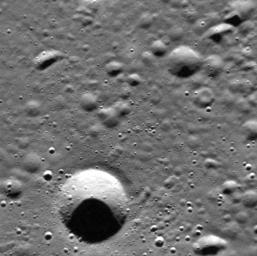
|
This Erosion
- Click the image above for a larger view
- Full-Res JPEG (1024 x 1020) (143.3 kB)
- Full-Res TIFF (1024 x 1020) (1.0 MB)
Caption:
This view of Mercury's surface illustrates the process of erosion on the innermost planet. At present on Earth, the dominant agents that work to wear down the landscape are flowing water, moving ice (glaciers), and blowing wind. Mercury lacks these agents, and its atmosphere is far too thin to offer protection from cosmic impacts. As a result, Mercury's surface is exposed to impact cratering by objects ranging from micrometer-sized dust motes to multi-kilometer asteroids and comets. Here we see craters in various stages of degradation. Some craters have been worn down to mere dimples, while other, younger, impacts still retain their original shapes. Craters that have a non-circular shape or that occur in clusters are probably secondary craters formed when material ejected from primary impacts falls back to the surface.
This image was acquired as a high-resolution targeted observation. Targeted observations are images of small areas on Mercury's surface at resolutions much higher than the 250-meter/pixel (820 feet/pixel) morphology base map or the 1-kilometer/pixel (0.6 miles/pixel) color base map. It is not possible to cover all of Mercury's surface at this high resolution during MESSENGER's one-year mission, but several areas of high scientific interest are generally imaged in this mode each week.
Date acquired:
April 05, 2011
Image Mission Elapsed Time (MET):
210460801
Image ID:
91858
Instrument:
Narrow Angle Camera (NAC) of the Mercury Dual Imaging System (MDIS)
Center Latitude:
73.0°
Center Longitude:
4.0° E
Resolution:
16 meters/pixel
Scale:
The scene is about 16 km (10 mi.) across.
Background Info:
On March 17, 2011 (March 18, 2011, UTC), MESSENGER became the first spacecraft ever to orbit the planet Mercury . The mission is currently in its commissioning phase, during which spacecraft and instrument performance are verified through a series of specially designed checkout activities. In the course of the one-year primary mission, the spacecraft's seven scientific instruments and radio science investigation will unravel the history and evolution of the Solar System's innermost planet. Visit the Why Mercury? section of this website to learn more about the science questions that the MESSENGER mission has set out to answer.
These images are from MESSENGER, a NASA Discovery mission to conduct the first orbital study of the innermost planet, Mercury. For information regarding the use of images, see the MESSENGER image use policy .
Cataloging Keywords:
| Name | Value | Additional Values |
|---|---|---|
| Target | Mercury | |
| System | ||
| Target Type | Planet | |
| Mission | MESSENGER | |
| Instrument Host | MESSENGER | |
| Host Type | Orbiter | |
| Instrument | Mercury Dual Imaging System (MDIS) | |
| Detector | Narrow Angle Camera (NAC) | |
| Extra Keywords | Atmosphere, Crater, Dust, Grayscale, Impact, Map, Radio, Water | |
| Acquisition Date | ||
| Release Date | 2011-04-20 | |
| Date in Caption | 2011-04-05 | |
| Image Credit | NASA/Johns Hopkins University Applied Physics Laboratory/Carnegie Institution of Washington | |
| Source | photojournal.jpl.nasa.gov/catalog/PIA14202 | |
| Identifier | PIA14202 | |
